Information produced by ADM Investor Services, Inc. and distributed by Stewart-Peterson Inc.
Wheat prices overnight are down 6 in SRW, down 5 in HRW, down 7 3/4 in HRS; Corn is down 1/4; Soybeans down 1; Soymeal down $0.42; Soyoil up 0.22.
For the week so far wheat prices are down 2 1/2 in SRW, up 17 3/4 in HRW, up 14 3/4 in HRS; Corn is up 4 1/2; Soybeans up 41 3/4; Soymeal up $1.06; Soyoil up 0.98.
For the month to date wheat prices are down 19 1/4 in SRW, up 53 3/4 in HRW, up 5 1/4 in HRS; Corn is up 19; Soybeans down 5 1/2; Soymeal down $11.40; Soyoil down 5.45.
Year-To-Date nearby futures are down 13.4% in SRW, down 2.5% in HRW, down 7.1% in HRS; Corn is down 4.6%; Soybeans down 3.2%; Soymeal down 4.8%; Soyoil down 15.0%.
Like what you’re reading?
Sign up for our other free daily TFM Market Updates and stay in the know!
Chinese Ag futures (JUL 23) Soybeans up 26 yuan; Soymeal down 17; Soyoil up 110; Palm oil up 78; Corn down 16 — Malaysian Palm is down 18. Malaysian palm oil prices overnight were down 18 ringgit (-0.48%) at 3770.
There were changes in registrations (-44 Corn). Registration total: 2,537 SRW Wheat contracts; 23 Oats; 29 Corn; 166 Soybeans; 613 Soyoil; 1 Soymeal; 37 HRW Wheat.
Preliminary changes in futures Open Interest as of March 30 were: SRW Wheat up 1,781 contracts, HRW Wheat up 1,004, Corn down 1,983, Soybeans down 137, Soymeal up 673, Soyoil up 6,049.
Midwest Forecast: Another strong storm will move through the Midwest on Thursday into Saturday with widespread precipitation, severe storms, strong winds, and a band of snow across the north as we turn the calendar to April. A similar storm system is forecast for next week. The wetter conditions across a lot of the region are causing a slow start to fieldwork.
Northern Plains Forecast: Some occasional snow continues in the Northern Plains and Canadian Prairies Thursday, but a heavier band will form in South Dakota on Friday that could add to the snowpack. Cold temperatures will limit melting for yet another week and the risk of significant flooding is increasing when temperatures do turn higher, perhaps abruptly.
Central/Southern Plains Forecast: A larger storm builds across the Central and Southern Plains Thursday into Friday. Northern and eastern areas again look to have the best chance for precipitation while strong winds develop elsewhere, sapping soil moisture. The outlook for the southwestern Plains remains grim as this area gets missed by yet another large storm. A similar large storm is expected next week that should bring much of the same conditions as the storm this week.
Brazil Grains & Oilseeds Forecast: Wet season showers have become isolated through central Brazil and are forecast to remain that way through April, leaving some concern for enough available soil moisture for developing safrinha corn. Systems moving through Argentina will bring showers into southern Brazil, however, which may enhance showers there at times.
Argentina Grains & Oilseeds Forecast: Argentina continues to be active with several more fronts moving through with more showers going into April. Heavy rain last week and this week is too late to turn around damaged corn and soybeans. Temperatures look to waffle a bit more as fall harvest time nears.
The player sheet for 3/30 had funds: net sellers of 6,000 contracts of SRW wheat, sellers of 1,500 corn, sellers of 2,000 soybeans, buyers of 2,000 soymeal, and sellers of 3,000 soyoil.
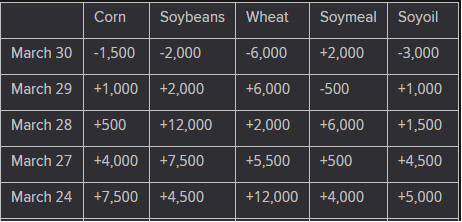
TENDERS
- CORN SALE: The U.S. Department of Agriculture on Thursday confirmed private sales of 178,000 tonnes of U.S. corn to China for delivery in the 2022/23 marketing year that began Sept. 1, 2022.
- WHEAT PURCHASE: Turkey’s state grain board TMO has purchased 395,000 tonnes of milling wheat out of a tender for 695,000 tonnes held on Tuesday, traders said on Thursday. Traders had initially reported that TMO had purchased the full amount it had tendered for but tonnages in TMO’s tenders are provisional and can be reduced or cancelled completely in the following days.
- WHEAT TENDER: Jordan’s state grain buyer has issued an international tender to buy up to 120,000 tonnes of milling wheat which can be sourced from optional origins.
- FEED BARLEY TENDER: Jordan’s state grains buyer has issued a new international tender to purchase up to 120,000 tonnes of animal feed barley.
PENDING TENDERS
- CORN TENDER: Algerian state agency ONAB issued an international tender to purchase up to 70,000 tonnes of animal feed corn to be sourced from Argentina or Brazil.
- RICE TENDER: South Korea’s Agro-Fisheries & Food Trade Corp issued an international tender to purchase an estimated 121,800 tonnes of rice.
US BASIS/CASH
- Basis bids for soybeans shipped by barge to the U.S. Gulf Coast firmed on Thursday, and corn eased, as investors prepared for a pair of key U.S. crop reports due on Friday from the U.S. Department of Agriculture (USDA), traders said.
- Rates for empty barges on Midwest Rivers were steady to mixed, with spot rates ticking slightly up on Mississippi River at St. Paul to Savage, Minnesota; at McGregor, Iowa; and at Davenport and South.
- CIF Gulf soybean barges loaded in March were bid at 111 cents over May, up 4 cents from Wednesday. April soy barges down 1 cent at 99 cents over futures.
- FOB basis offers for April soybean export loadings were around 118 cents over futures, up 1 cent from Wednesday; May offers were steady at around 111 cents over futures.
- For corn, CIF barges loaded in March were bid at 94 cents over May, down 1 cent, while April corn barges were bid down 1 cent at 93 cents over futures.
- FOB basis offers for April corn export loadings were offered at 105 cents over futures, up 1 cent from Wednesday, while May loadings were steady at around 100 cents over futures.
- Spot basis bids for corn rose at rail terminals in the eastern U.S. Midwest on Thursday, grain dealers said.
- The corn basis was steady to weak at processors, falling by 5 cents a bushel near Chicago, and flat along rivers.
- Slow farmer sales of corn in recent months has made it more difficult to find enough supplies to fill railcars.
- Farmer sales remained slow on Thursday, with growers waiting to see the market impact of the U.S. Agriculture Department’s annual Prospective Plantings report on Friday.
- Basis bids for soybeans delivered on the cash market were unchanged at processors, elevators and river terminals around the Midwest.
- Dealers said that farmers also were showing little interest in booking deals for their soybeans.
- Spot basis bids for corn were steady to weak at processors, elevators and river terminals around the U.S. Midwest early on Thursday, grain dealers said.
- The corn basis was steady at the region’s ethanol plants.
- Soybean bids also were steady to weak at elevators but steady to firm at processors, rising by 5 cents a bushel in Morristown, Indiana.
- The soy basis was flat along rivers.
- U.S. spot cash millfeed values were steady to slightly higher on Thursday, as mill run times are expected to continue slowing ahead of the Good Friday holiday, ingredient dealers said.
- Field and river flooding are expected in North Dakota and surrounding regions, as meteorologists are calling for heavy snowfall next week, according to a market report by T-Storm Weather.
- The report said that thunderstorms forecast to impact the Corn Belts and mid-South are expected to bypass hard red winter wheat growing areas in the Plains, as dry to drought conditions intensify.
- Spot basis bids for hard red winter wheat were unchanged across the southern U.S. Plains at rail and truck market elevators on Thursday, grain dealers said.
- Farmers were showing little interest in booking new deals for their grain, an Oklahoma dealer said.
- Offers for soymeal delivered on the spot market fell at rail terminals around the U.S. Midwest on Thursday, dealers said.
- The soymeal basis was steady at most Midwest processors in the truck market.
- Activity on the cash market was quiet, a rail broker said.
- Although the truck market basis was mostly steady, offers rose by $2 per ton in Iowa Falls, Iowa.
US Agriculture Export Sales for Week Ending March 23
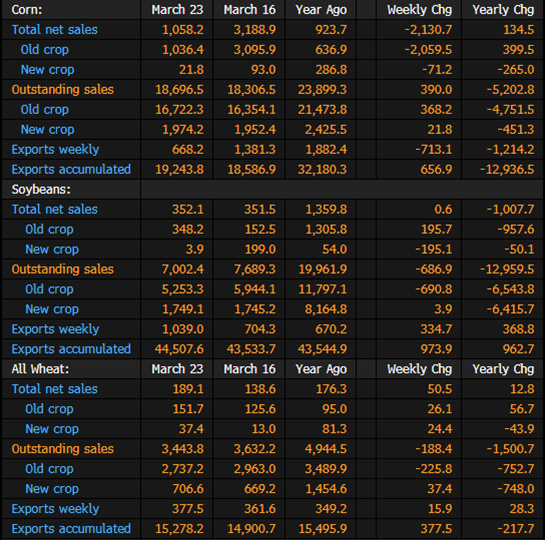
US Export Sales of Soybeans, Corn and Wheat by Country
The following table shows US export sales of soybeans, corn and wheat by biggest net buyers for week ending March 23, according to data on the USDA’s website.
- China bought 709k tons of the 1.1m tons of corn sold in the week
- China also led in soybean purchases, and Mexico was the top buyer of wheat
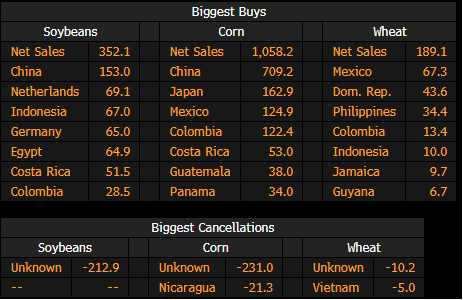
US Hogs and Pigs Inventory for March 1: Summary

EU Pegs 2023-24 Grain Harvest Up 8.4% Y/y, Oilseeds at Record
Total grain production in the EU is seen rising 8.4% y/y in the 2023-24 season to 287.9m tons, assuming normal weather, the European Commission said Thursday in a report.
- Exports may increase by a similar level
- Soft-wheat crop seen at 130.9m, barley at 54.2m tons and corn at 65m tons
- Oilseed production seen at a record 33.6m tons, up 7% y/y
- Rapeseed plantings rose due to high prices
- Sugar-beet plantings in 2023 could fall 3% below the 5-year average to 1.455m hectares, following the ruling against neonicotinoid use
Brazil’s Parana Soy Production Estimate Raised by 6% by Deral
Soybean production in Parana, Brazil’s second largest growing state, is seen at 22.2 million tons, up from 20.9m tons last month, the state’s rural economy department Deral says in report.
- Output seen jumping from 12.2m tons last season
- Harvest is 77% complete vs 17% a month earlier
- Winter-corn crop seen at 14.7m tons, down from 15.4m tons a month earlier
- Output may rise 10.5% y/y
- Seeding is 93% complete vs 26% last month
- 98% of corn crops are in good shape
Argentina’s Rosario ports operating normally despite strike – chamber
Argentina’s Rosario agro-port hub terminals were operating normally on Thursday in the midst of a strike by the Urgara grain receivers union aimed at storage centers, the country’s Chamber of Port and Maritime Activities (CAPyM) said.
“The ports are not affected,” Guillermo Wade, manager of CAPyM, told Reuters, adding that, at most, “those who have stocks will be receiving a little less merchandise or less than the estimated, but they are very specific cases.”
Grain receivers are technicians who analyze the merchandise stored in collection centers distributed throughout the country, as well as when it’s loaded onto ships.
Argentina is the world’s leading exporter of soybean oil and meal, and the third largest in corn. Nearly 80% of grain shipments and almost all of the country’s exports of soybean derivatives come out of the Rosario agro-port cordon.
In the current agricultural season, Argentina has been affected by a historic drought that has caused serious losses and is on a path to leave the country’s soybean production at its lowest level in decades.
Argentine Soybean, Corn Estimates March 30: Exchange
The Buenos Aires Grain Exchange releases weekly report on website.
- 2022-23 soybean production held at 25m tons
- Corn production held at 36m tons
- The following table compares most current data to previous week and last year’s crop:

Argentina Unleashes ‘Dollar Malbec’ to Help Exports Amid Drought
- Argentina to provide temporary FX relief to farmers, producers
- Measure a bid to boost exports as severe drought hits economy
Argentina is rolling out a temporary, subsidized exchange rate for wine and other agriculture products in an elaborate bid to boost exports and foreign reserves as the worst drought in a century exacerbates a looming recession.
Economy Minister Sergio Massa confirmed Thursday he’s going forward with the exchange rate measure, dubbed “Dollar Agro” or “Dollar Malbec” by the Argentine press because it benefits the producers of the country’s most-well known wine grape.
The policy will give producers a more beneficial exchange rate for 90 days when they sell their products abroad, including rice and peanuts, instead of the official peso value that the government has kept artificially high in a bid to avoid devaluation.
Starting in April, the government will also allow a 30-day exchange rate for soy exports, the third version of the measure for that product, according to an Economy Ministry statement Thursday, which didn’t specify the new exchange rate level for any of the products.
Argentina’s official rate closed Thursday at about 209 pesos per dollar and previous versions of the soy exchange rate were well above the official. In black market exchanges, the local currency trades at half its value, or about 400 pesos per dollar.
“The drought hit us very hard,” Massa told reporters in Washington Thursday after meeting with officials at the International Monetary Fund. The temporary exchange rates aim to “strengthen the central bank’s reserves in the second quarter and continue the stabilization path that Argentina needs to do.”
To be sure, wine exports alone — just over $1 billion annually — won’t turn around Argentina’s economic outlook. However, with the measure the government also seeks to get every dollar it can from exports as central bank reserves have fallen from $44.6 billion at the start of the year to $36.6 billion now, near the lowest level since 2016.
A farmer walks trough soy plants that struggle to survive amid a severe drought in San Jerónimo Sud, Argentina, earlier in March.
The Buenos Aires Grains Exchange has slashed its annual soy production forecast to 25 million metric tons, far below the five-year average of 45 million tons and the worst figure in decades. The Argentine economy greatly depends on farming exports to generate dollars.
Special rates for soy last year forced Argentina to request waivers for the government’s $44 billion agreement with the IMF because it broke the lender’s rules on “multiple currency practices.” The IMF’s executive board is expected to approve a new $5.3 billion disbursement to Argentina in coming days as part of the program’s total following the fourth staff-level review.
Those past soy rates boosted exports in the short-term but also raised concerns about pumping more pesos into the economy as inflation is already running above 100%.
Malaysia’s March 1-31 Palm Oil Exports 1,402,142 Tons: AmSpec
Shipments jump 32% m/m from 1,062,057 tons exported during Feb. 1-28, according to AmSpec Agri in a statement.
French Soft-Wheat Ratings Hold Steady, Durum Falls: AgriMer
The amount of France’s soft-wheat crop in good or very good condition held at 94% as of March 27, the same as the prior week, FranceAgriMer data showed on Friday.

Viterra Seeks to Sell Part of Stake in Key Russia Grain Terminal
- Company has made offer to Demetra, which owns the rest
- Move comes as western grain traders pull back from Russia
Glencore-backed Viterra has offered to sell half its 50% stake in a major Black Sea grain terminal to Russia’s Demetra Trading, which owns the rest, according to people familiar with the matter.
The Taman terminal is one of the largest in Russia, with grain storage capacity of 200,000 tons, according to the company’s website. No sale has yet been agreed, but there are conversations happening about price, the people said.
The discussions come as Viterra, along with Cargill Inc., readies to halt purchases of Russian grain for export, as trade grows more complicated during the war and international merchants face pressure from Moscow and the local industry to leave, Bloomberg reported this week.
The companies are the two biggest western shippers from Russia, the world’s top wheat exporter, and both have export assets there. What happens to those facilities could give an indication of which local firms stand to gain.
Viterra did not immediately respond to a request for comment. State-controlled VTB Group is one of the shareholders of Demetra.
The country’s agriculture ministry said on Wednesday that Russia is ready to work with all foreign companies that contribute to its export potential, while adding that any gaps in the market are being filled by Russian companies.
More Than 20% of Turkey’s Food Output Lost From Earthquakes: FAO
The earthquakes that struck Turkey in February spurred severe damage to crops, livestock and fisheries, the UN’s Food and Agriculture Organization said Friday in a report.
- Initial assessment points to $1.3b in damage and $5.1b in losses to the agriculture sector
- Access to inputs has become “increasingly challenging” and growers are facing labor shortages
- “This precarious situation raises further concerns as the summer harvest season draws near”
- NOTE: Turkey’s largest crop sectors by volume include wheat, sugar-beet, tomatoes and corn, FAO data show
- Estimate of damages and losses in Syria is ongoing
Fertilizer Prices Fall 26% in Break for Price Squeezed Farmers
- Tampa ammonia falls to likely floor, BI analyst Maxwell says
- Price drop hits as US corn farmers prepare for growing season
Farmers who balked at high fertilizer costs ahead of the current growing season are poised for relief as the price for a key nitrogen fertilizer drops 26% on robust supply and dwindling demand.
The spot Tampa anhydrous ammonia contract for April fell to $435 a metric ton cost and freight, down from $590 in March, according to Bloomberg’s Green Markets.
Prices have probably hit a floor, BI analyst Alexis Maxwell said, but they aren’t likely to rise significantly again soon. That means it’s a good time to scoop up product, she said. Farmers have held back buying nutrients as the price of natural gas, the main input for most nitrogen fertilizer, has been declining, in hopes that retail costs will fall.
Read More: Fertilizer Outlook at Risk as Cool Spring Threatens Plantings
Tanking prices could bring relief to farmers, who have faced rising costs for everything that goes into growing food, from chemicals and fuel to equipment and labor. Wholesale prices of Tampa ammonia, the world’s benchmark, have plummeted 73% from a high last April, after Russia’s invasion of Ukraine roiled multiple supply chains affecting global fertilizer trade and production.
The drop indicates retail prices will ease, even if there’s a lag. That brightens the outlook for grain harvests needed to replenish the world’s war-strained food reserves.
“We believe the worst has passed” for farmers, Maxwell said. “If I were a retailer looking to buy from a producer, I’d secure my supply for the farmers.”
US Miss. River Grain Shipments Rise, Barge Rates Increase: USDA
Barge shipments down the Mississippi river increased to 651k tons in the week ending March 25 from 578k tons the previous week, according to the USDA’s weekly grain transportation report.
- Barge shipments of corn rose 34% from the previous week
- Soybean shipments down 9% w/w
- St. Louis barge rates were $17.53 per short ton, an increase of $0.12 from the previous week
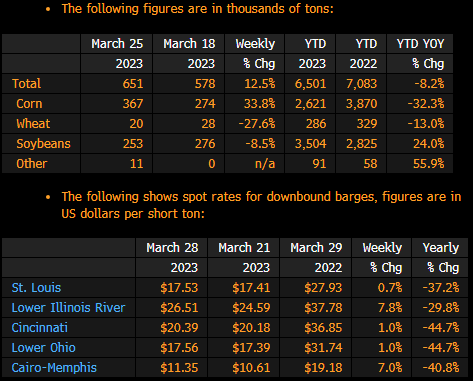
UNITED STATES
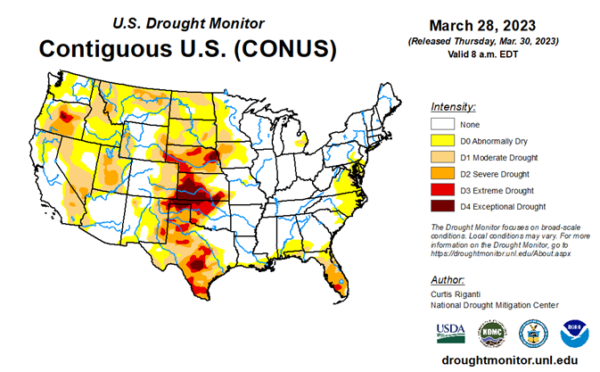

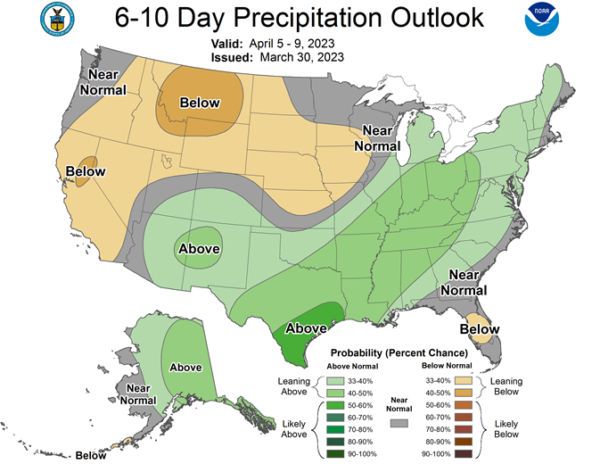

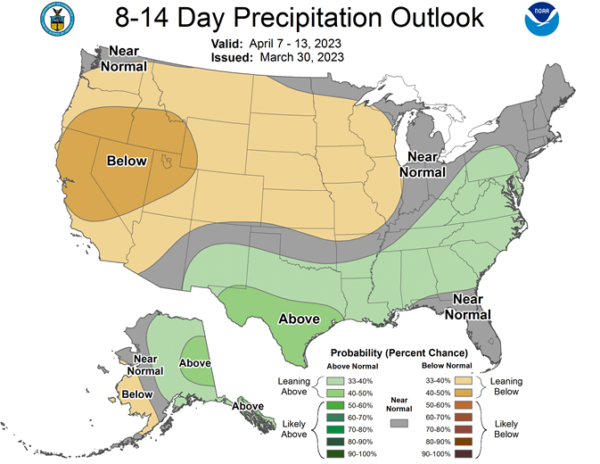
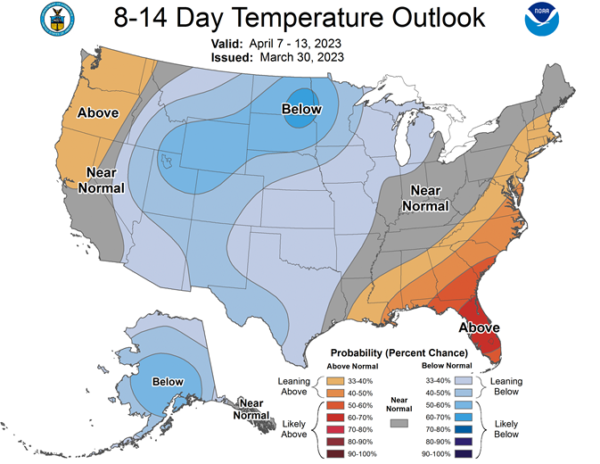
SOUTH AMERICA

This commentary is provided by ADM Investor Services, a futures brokerage firm and wholly owned subsidiary of ADM Company. ADMIS has provided expert market analysis and price risk management strategies to commercial, institutional and individual traders for more than 50 years. Please visit us at www.admis.com or contact us at sales@admis.com to learn more.
Futures and options trading involve significant risk of loss and may not be suitable for everyone. Therefore, carefully consider whether such trading is suitable for you in light of your financial condition. The information and comments contained herein is provided by ADMIS and in no way should be construed to be information provided by Archer Daniels Midland Company. The author of this report did not have a financial interest in any of the contracts discussed in this report at the time the report was prepared. The information provided is designed to assist in your analysis and evaluation of the futures and options markets. However, any decisions you may make to buy, sell or hold a futures or options position on such research are entirely your own and not in any way deemed to be endorsed by or attributed to ADMIS.
| CONFIDENTIALITY NOTICE
This message may contain confidential or privileged information, or information that is otherwise exempt from disclosure. If you are not the intended recipient, you should promptly delete it and should not disclose, copy or distribute it to others. |

